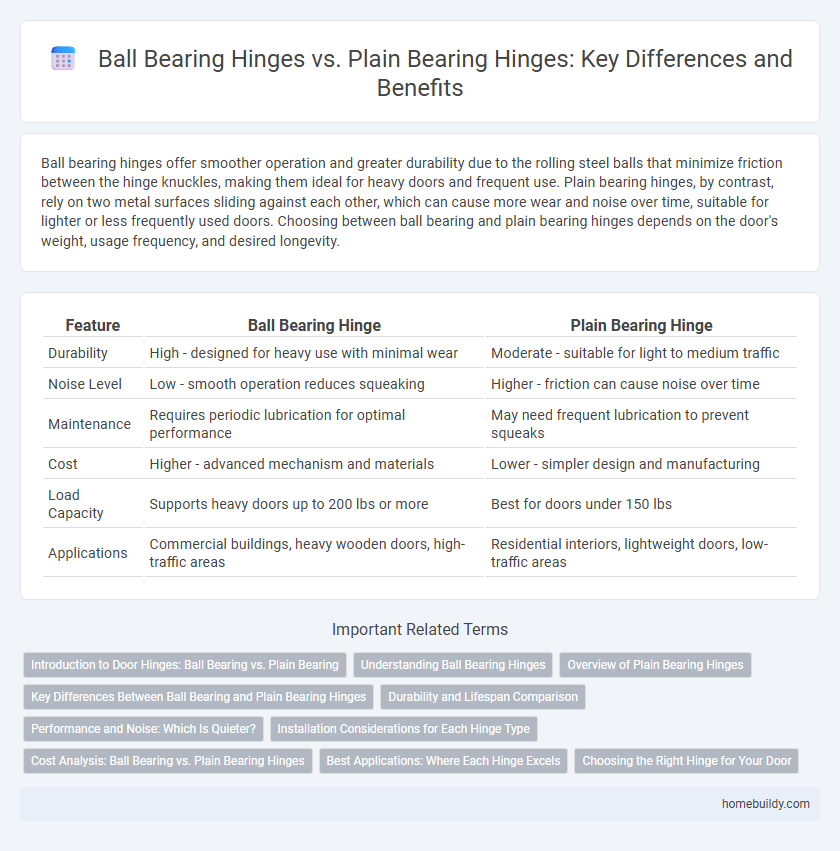Ball bearing hinges offer smoother operation and greater durability due to the rolling steel balls that minimize friction between the hinge knuckles, making them ideal for heavy doors and frequent use. Plain bearing hinges, by contrast, rely on two metal surfaces sliding against each other, which can cause more wear and noise over time, suitable for lighter or less frequently used doors. Choosing between ball bearing and plain bearing hinges depends on the door's weight, usage frequency, and desired longevity.
Table of Comparison
| Feature | Ball Bearing Hinge | Plain Bearing Hinge |
|---|---|---|
| Durability | High - designed for heavy use with minimal wear | Moderate - suitable for light to medium traffic |
| Noise Level | Low - smooth operation reduces squeaking | Higher - friction can cause noise over time |
| Maintenance | Requires periodic lubrication for optimal performance | May need frequent lubrication to prevent squeaks |
| Cost | Higher - advanced mechanism and materials | Lower - simpler design and manufacturing |
| Load Capacity | Supports heavy doors up to 200 lbs or more | Best for doors under 150 lbs |
| Applications | Commercial buildings, heavy wooden doors, high-traffic areas | Residential interiors, lightweight doors, low-traffic areas |
Introduction to Door Hinges: Ball Bearing vs. Plain Bearing
Ball bearing door hinges feature rolling steel balls between the hinge knuckles, reducing friction and allowing smoother, quieter operation ideal for heavy or frequently used doors. Plain bearing hinges consist of simple metal-on-metal contact without bearings, making them more affordable but prone to increased wear and noise over time. Choosing between ball bearing and plain bearing hinges depends on door weight, frequency of use, and desired durability.
Understanding Ball Bearing Hinges
Ball bearing hinges incorporate small steel balls between the hinge knuckles, reducing friction and ensuring smoother, quieter door operation compared to plain bearing hinges. These hinges offer enhanced durability and resist wear, making them ideal for heavy or high-traffic doors. Their superior load-bearing capacity and longer lifespan provide a cost-effective solution for both residential and commercial applications.
Overview of Plain Bearing Hinges
Plain bearing hinges feature a simple design with a sleeve that rotates around a pin, offering smooth operation without the need for lubrication. These hinges typically provide quieter motion and are more resistant to dirt and debris, making them suitable for interior doors and light-duty applications. Their lower cost and ease of installation make plain bearing hinges a practical choice for residential use where heavy load capacity is not required.
Key Differences Between Ball Bearing and Plain Bearing Hinges
Ball bearing hinges feature steel balls between hinge knuckles, reducing friction and providing smoother, quieter door operation with greater durability under heavy use. Plain bearing hinges use a simple metal-on-metal surface, resulting in higher friction and more wear over time, making them less ideal for high-traffic doors. Key differences include load capacity, noise level, maintenance requirements, and lifespan, with ball bearing hinges preferred for heavy, exterior, or frequently used doors.
Durability and Lifespan Comparison
Ball bearing hinges feature steel balls between the hinge knuckles, reducing friction and wear, which significantly enhances durability and extends lifespan compared to plain bearing hinges. Plain bearing hinges rely on metal-on-metal contact, causing more friction that accelerates wear and often necessitates earlier replacement. Consequently, ball bearing hinges are the preferred choice for high-traffic doors due to their superior longevity and consistent performance.
Performance and Noise: Which Is Quieter?
Ball bearing hinges offer superior performance and durability by incorporating precision steel balls that reduce friction and wear, resulting in smoother door movement. Plain bearing hinges rely on a simple metal-on-metal surface, which can cause more friction, leading to increased noise and faster deterioration. In terms of noise, ball bearing hinges are significantly quieter due to their efficient friction management, making them the preferred choice for residential and commercial applications where silence is important.
Installation Considerations for Each Hinge Type
Ball bearing hinges require precise alignment during installation to ensure smooth, long-lasting operation and reduce friction between moving parts. Plain bearing hinges offer simpler installation with fewer alignment constraints but may need more frequent lubrication and maintenance to prevent wear. Selecting the right hinge depends on balancing installation complexity with long-term durability and maintenance preferences.
Cost Analysis: Ball Bearing vs. Plain Bearing Hinges
Ball bearing hinges typically cost 20-30% more than plain bearing hinges due to their enhanced durability and smoother operation. Plain bearing hinges are more budget-friendly but may require more frequent maintenance and replacement, increasing long-term expenses. Investing in ball bearing hinges can reduce overall maintenance costs and downtime in high-traffic applications.
Best Applications: Where Each Hinge Excels
Ball bearing hinges excel in high-traffic areas such as commercial buildings and heavy doors, providing smooth operation and durability under frequent use. Plain bearing hinges are best suited for lighter doors in residential settings where noise reduction and cost efficiency are priorities. Each hinge type optimizes performance based on door weight, frequency of use, and environmental conditions.
Choosing the Right Hinge for Your Door
Ball bearing hinges offer superior durability and smooth operation by reducing friction with rolling steel balls, making them ideal for heavy doors or high-traffic areas. Plain bearing hinges, featuring a simple metal-to-metal contact design, provide cost-effective functionality but may wear faster under frequent use. Selecting the right hinge depends on door weight, usage frequency, and desired longevity to ensure optimal performance and maintenance requirements.
ball bearing hinge vs plain bearing hinge Infographic

 homebuildy.com
homebuildy.com